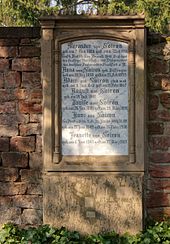Alexander of Soiron
Johann Georg Alexander Freiherr von Soiron (born August 2, 1806 in Mannheim ; † May 6, 1855 in Heidelberg ) was a Baden politician and member of the Frankfurt National Assembly .
After studying law at the University of Heidelberg and Bonn , Soiron became a court attorney in Mannheim in 1834. During his studies he joined the old Heidelberg fraternity in 1824 . In 1832 he and his friends Erhard Joseph Brenzinger , Karl Mathy and Friedrich Daniel Bassermann took part in the Hambach Festival . In 1845 he became a member of parliament for Lahr in the Second Chamber of the Baden Estates Assembly , where he was part of the liberal wing.
In 1847 Alexander von Soiron took part in the Heppenheim conference , and in 1848 in the people's assemblies in Offenburg and Heidelberg. He was a member of the pre-parliament and was president of the Fifties Committee . Via the constituency of Adelsheim , he became a member of the Frankfurt National Assembly, where he was part of the casino parliamentary group . Soiron served as first vice-president at the beginning of the National Assembly and was a member of several committees, including the Constitutional Committee and the Imperial Deputation . At the end of May 1849 he resigned from his seat.
In the Erfurt Union Parliament he was chairman of the constitutional committee. In 1851 he withdrew from politics and worked as a lawyer until his death .
He was married from 1840 to Anna Bissinger (1818-1893), daughter of the Mannheim wine and diner Karl Bissinger (1780-1847) and sister of the landscape painter Joseph August Bissinger . The city of Mannheim named a street after him (Soironstraße in the Mannheim district of Wohlhotels ) and maintains his grave in Mannheim's main cemetery as a grave of honor . The grave is a sandstone stele in neo-Gothic shape with a marble slab and a bulbous frame. An inverted round arch frieze serves as a cornice finish.
literature
- Helge Dvorak: Biographical Lexicon of the German Burschenschaft. Volume I: Politicians. Sub-Volume 5: R – S. Winter, Heidelberg 2002, ISBN 3-8253-1256-9 , pp. 449-450.
- Rudolf Haas, Wolfgang Münkel: Guide to the graves of well-known Mannheim personalities . Mannheim 1981.
- Christian Jansen: Soiron, Johann Georg Alexander Freiherr von. In: New German Biography (NDB). Volume 24, Duncker & Humblot, Berlin 2010, ISBN 978-3-428-11205-0 , pp. 544-546 ( digitized version ).
- Friedrich von Weech : Alexander von Soiron : in: Friedrich von Weech (Hrsg.): Badische Biographien . Second part . Bassermann, Heidelberg 1875, pp. 301–303 ( digitized version )
- Karl Wippermann : Soiron, Alexander von . In: Allgemeine Deutsche Biographie (ADB). Volume 34, Duncker & Humblot, Leipzig 1892, pp. 551-553.
Individual evidence
- ^ Helge Dvorak: Biographical Lexicon of the German Burschenschaft. Volume I: Politicians. Sub-Volume 5: R – S. Winter, Heidelberg 2002, ISBN 3-8253-1256-9 , p. 449.
- ^ W. Münkel: Die Friedhöfe in Mannheim (SVA, 1992) p. 124.
| personal data | |
|---|---|
| SURNAME | Soiron, Alexander von |
| ALTERNATIVE NAMES | Soiron, Johann Georg Alexander Freiherr von (full name) |
| BRIEF DESCRIPTION | Baden politician and member of the Frankfurt National Assembly |
| DATE OF BIRTH | August 2, 1806 |
| PLACE OF BIRTH | Mannheim |
| DATE OF DEATH | May 6, 1855 |
| Place of death | Heidelberg |



